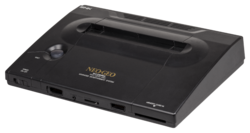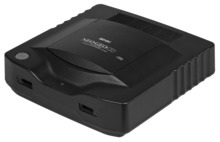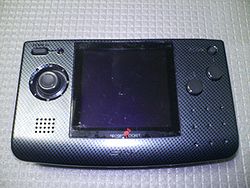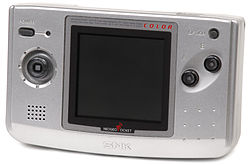- Neo Geo
-
This article is about the video game hardware. For the music album, see Neo Geo (album). For the arts movement, see Neo-Geo (arts).
Neo Geo 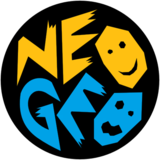
Type Video game console
Handheld game consoleOwner SNK Country Japan Introduced 1990 Discontinued 2004 Markets Japan (Worldwide Registered as a trademark in Japan (1990-2001)
Worldwide (1999-2000)Neo Geo (ネオジオ) was a family of video game hardware developed by SNK from 1990 to 1999, and fully discontinued in 2004.
Contents
Neo Geo MVS (1990)
The Neo Geo Multi Video System (MVS), is an arcade system board, being the first product in the Neo Geo family, and released in 1990. It was known to the coin-op industry, and offered arcade operators the ability to put up to 6 different arcade titles into a single cabinet, a key economic consideration for operators with limited floorspace. It comes in many different cabinets but basically consists of an add on board that can be linked to a standard Jamma system.
Neo Geo AES (1990)
Main article: Neo Geo AESThe Advanced Entertainment System (AES), originally known just as the Neo Geo, was the first console in the family, released in 1990. The hardware featured comparatively colourful 2D graphics.
The Neo Geo system was also marketed as a very costly home console, commonly referred to today as the AES (Advanced Entertainment System). The Neo Geo was marketed as 24-bit, though it was technically a 16-bit system with an 8-bit Zilog Z80 as coprocessor. The coprocessor was generally used for sound processing.
Initially, the (AES) home system was only available for rent to commercial establishments, such as hotel chains, bars and restaurants, and other venues. When customer response indicated that some gamers were willing to buy a $650 console, SNK expanded sales and marketing into the home console market. The Neo Geo console was officially launched on 31 January 1990 in Osaka, Japan.[1] Compared to the other 16-bit consoles of the time, Neo Geo's graphics and sound were vastly superior. Furthermore, since the AES was identical to its arcade counterpart, the MVS, arcade titles released for the home market were perfect translations. Although its high price tag kept it out of the mainstream gaming market, a strong game lineup likely contributed to the cult status of the Neo Geo, enabling it to outlast the more popular Super Nintendo and the Mega Drive.
Neo Geo CD (1994)
Main article: Neo Geo CDThe Neo Geo CD, released in 1994, was initially an upgrade from the original AES. This console uses CDs instead of ROM cartridges like the AES. The unit's (approximately) 1X CD-ROM drive was slow, making loading times very long with the system loading up to 56 Mbit of data between loads. Neo Geo CD game prices were low at $50, in contrast to Neo Geo AES game cartridges which cost as much as $300. The system could also play Audio CDs. All three versions of the system have no region-lock.
The Neo Geo CD was bundled with a control pad instead of a joystick like the AES. However, the original AES joystick could be used with all 3 Neo Geo CD models, instead of the included control pads.
Hyper Neo Geo 64 (1997)
 Neo Geo 64
Neo Geo 64 Main article: Neo Geo 64
Main article: Neo Geo 64The Hyper Neo Geo 64 was SNK's second and last arcade system board in the Neo Geo family, released in 1997. The Hyper Neo Geo 64 was conceived to usher SNK into the 3D era as well as to provide the hardware basis for a home system that would replace their aging Neo Geo AES, one that SNK hoped would be capable of competing with Sega's Saturn, Sony's PlayStation, Atari's Jaguar and Nintendo's Nintendo 64, as well as systems such as Panasonic's 3DO and Philips' CD-i.
Although details regarding the planned home system are sketchy, it is believed that like the AES machine, much of the hardware from the Neo Geo 64 arcade platform would also have been present in the home system, meaning gameplay would be identical or near-identical whether a given game was played at home or in the arcade. It is unknown what media the home system would have used, as cartridges had become expensive and obsolete, but offered up to around 1 gigabyte of storage space[citation needed], where CDs were cheaper to produce, but were limited to 750 megabytes of capacity and may not have been big enough to hold the game data.
In 1999, the Neo Geo 64 was discontinued, with only seven games released for it in two years.
Neo Geo Pocket (1998)
Main article: Neo Geo PocketThe Neo Geo Pocket was SNK's first handheld in the Neo Geo family. Featuring a monochrome display, it was released in late 1998; however, lower than expected sales resulted in its discontinuation in 1999, and was immediately succeeded by the Neo Geo Pocket Color (see below), which had a colour screen. The system only had a retail release within the Japan and Hong Kong market. The Pocket had a very short life.
Neo Geo Pocket Color (1999)
Main article: Neo Geo Pocket ColorThe Neo Geo Pocket Color was the last console of the Neo Geo family. It was released in 1999, just a few months before the original monochrome Pocket was discontinued. It was released this time also in the North American and European markets, rather than just the Japanese market. The Pocket Color featured a fancier color display screen.
The Pocket Color was discontinued in 2000 in Europe and North America, but continued to sell in Japan until 2001. There were only 2 million units sold worldwide. The Pocket Color was not really successful enough to beat the Game Boy Advance from Nintendo, which was extremely popular at that time.
References
- ^ http://mortal.shang.free.fr/pages/neo-geo.htm. Retrieved on 2010-03-39.
External links
- NeoGeoSoft.com: A complete software and artwork resource for the Neo Geo.
Categories:- Video game consoles
Wikimedia Foundation. 2010.


